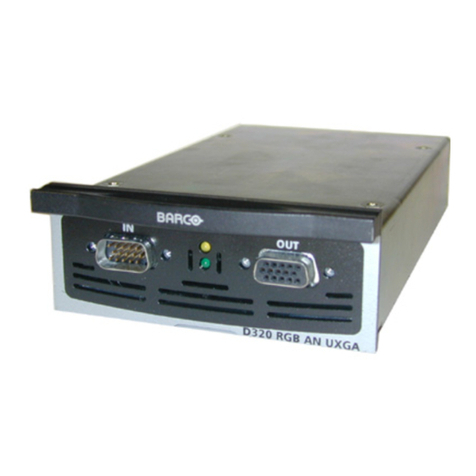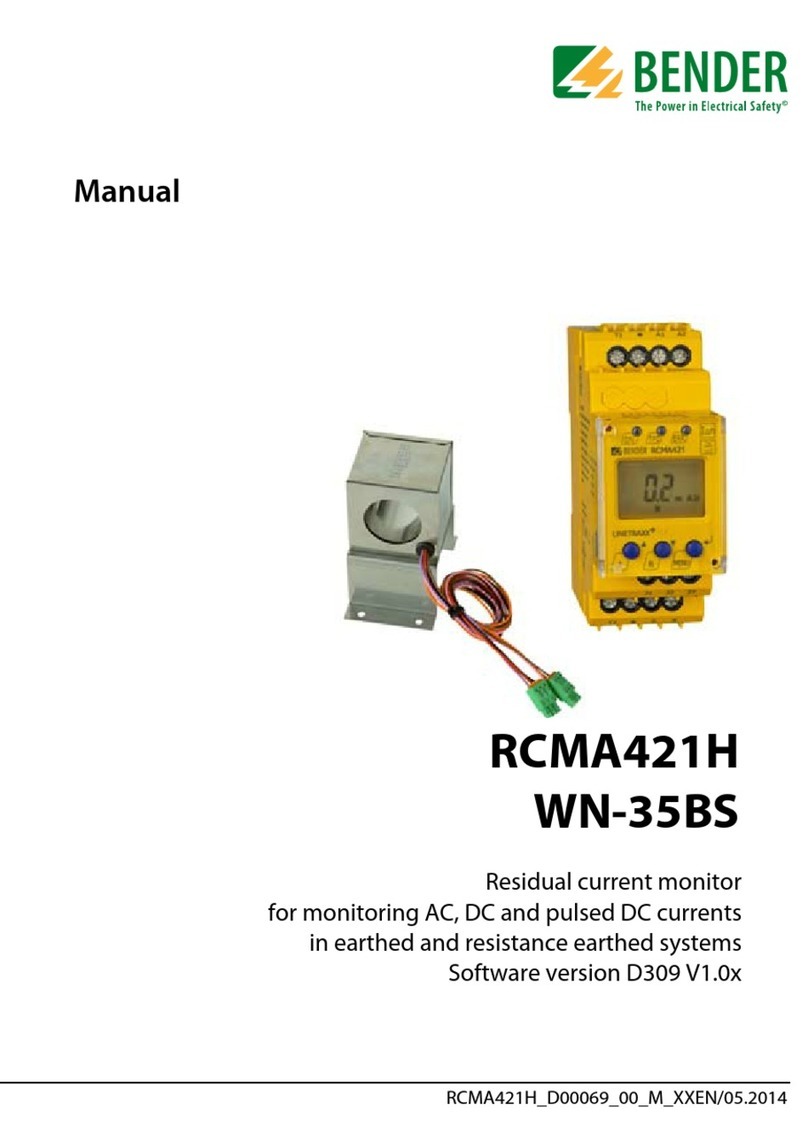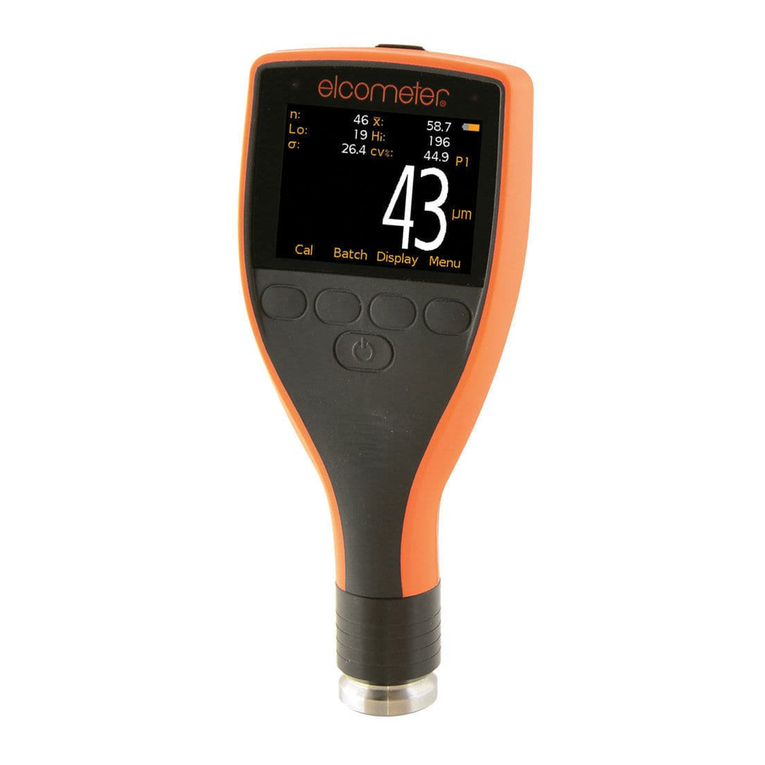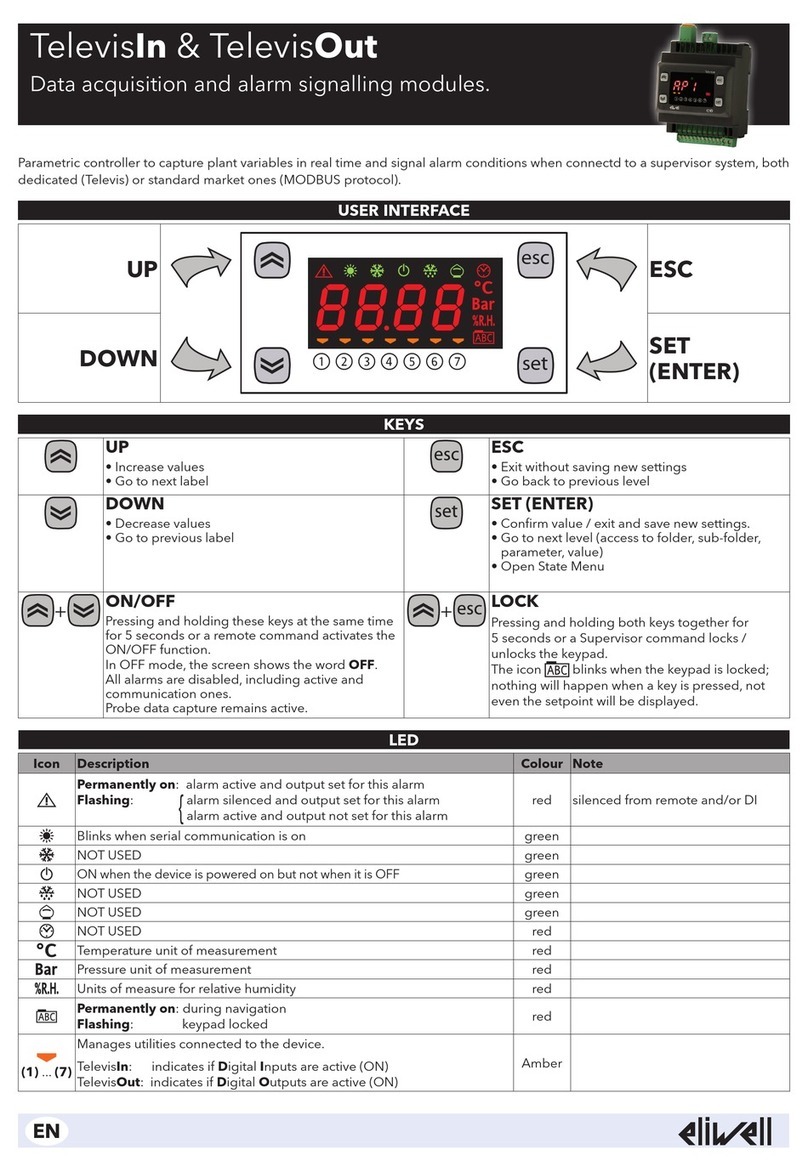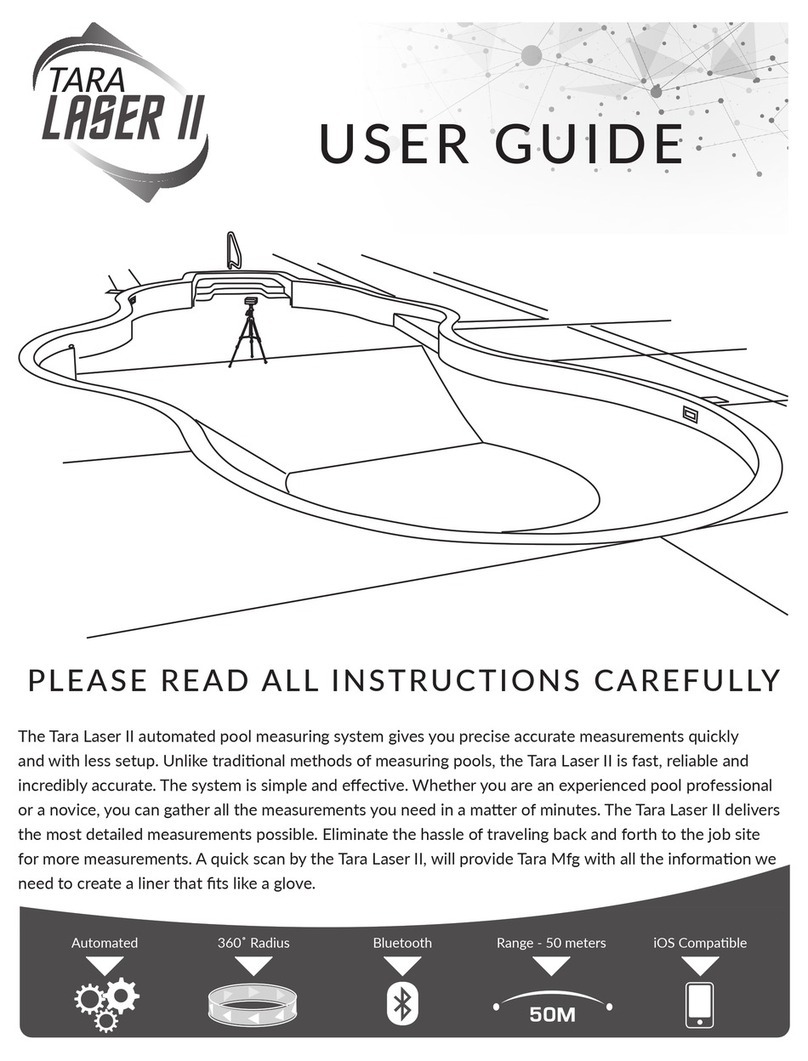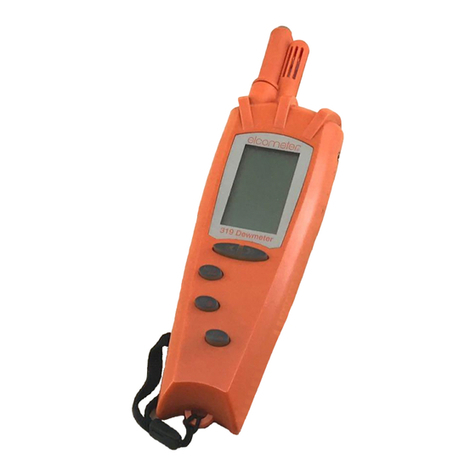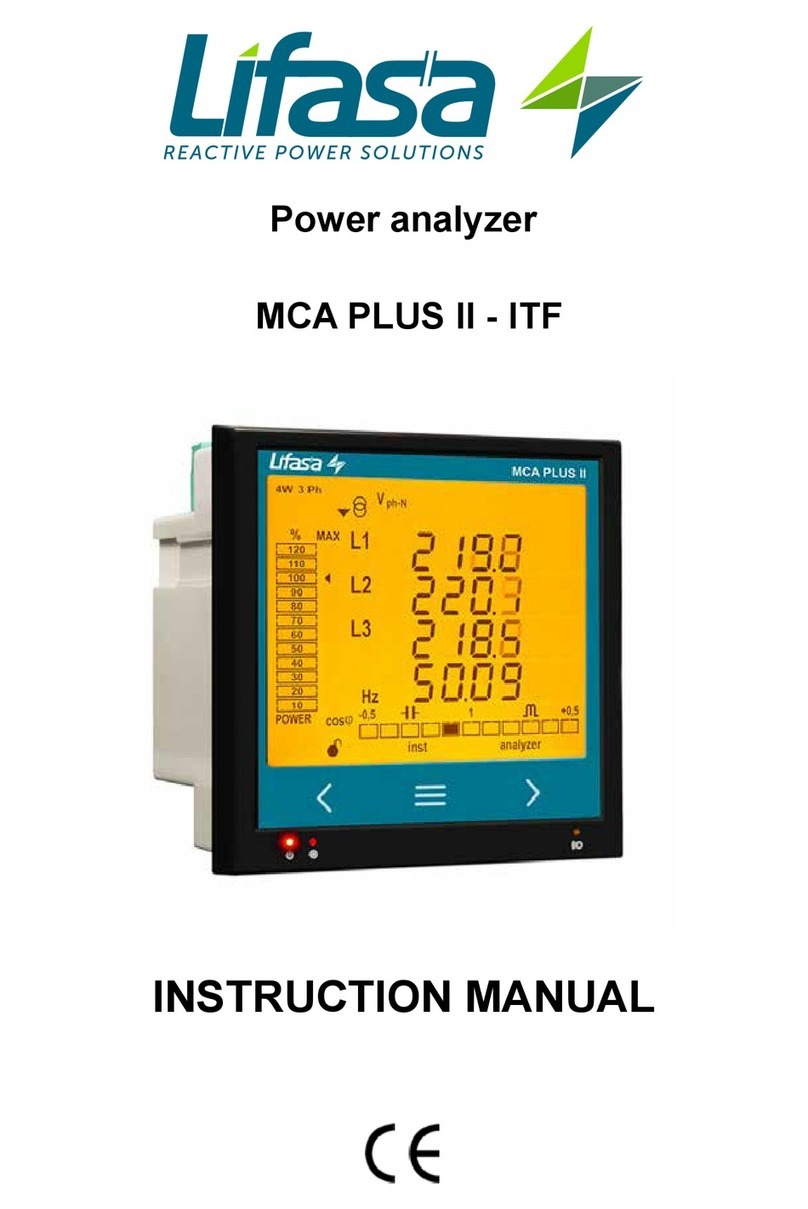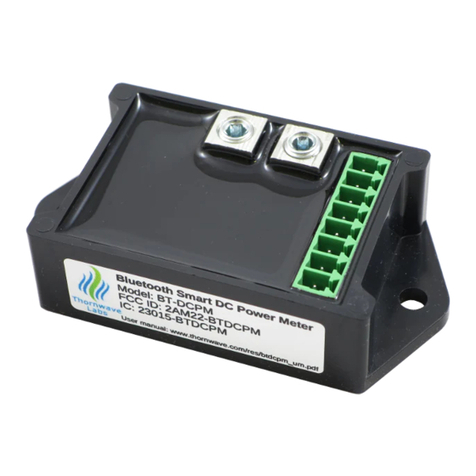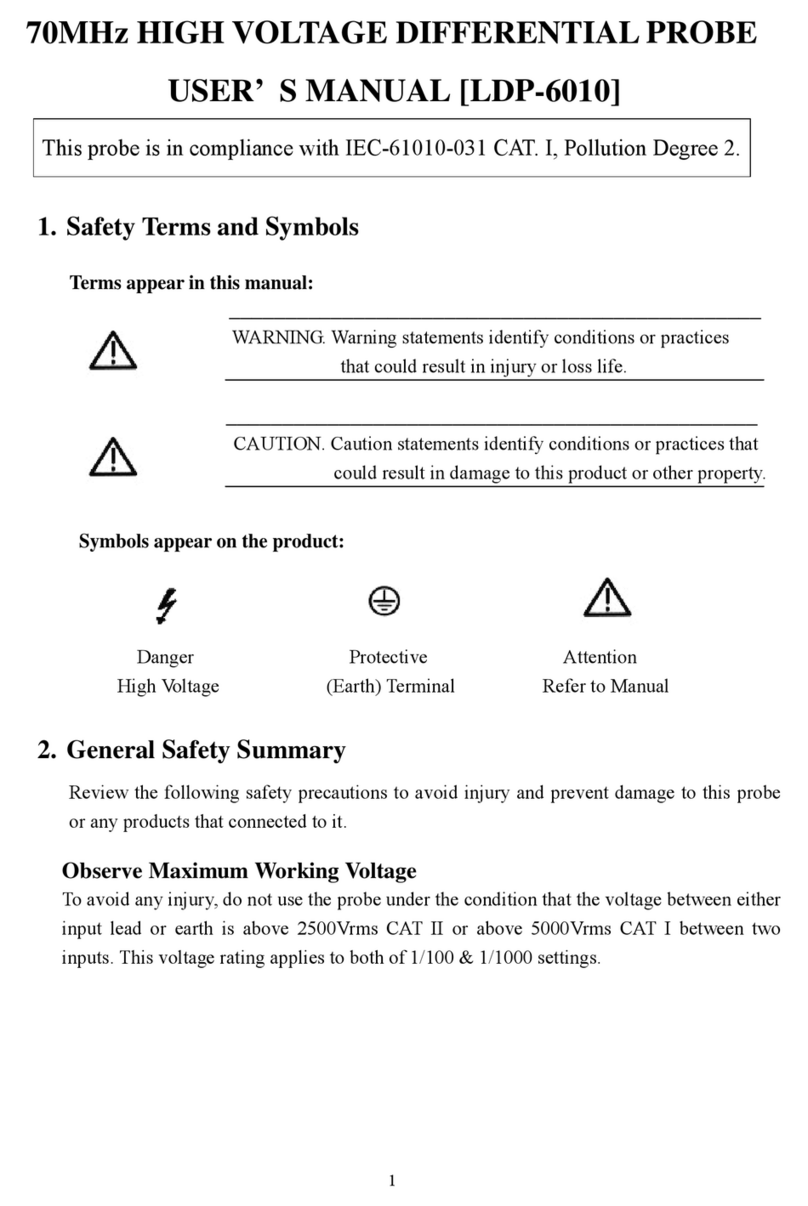Littelfuse SE-330 User manual

Tel: (800) 832-3873
Email: [email protected]
www.littelfuse.com/SE-330
Copyright © 2018 by Littelfuse
All rights reserved.
Document Number: PM-1200-EN
SE-330 MANUAL
NEUTRAL-GROUNDING-RESISTOR MONITOR
REVISION 11-A-063018

Page i
Rev. 11-A-063018
SE-330 Neutral-Grounding-Resistor Monitor
This page intentionally left blank.

Page ii
Rev. 11-A-063018
SE-330 Neutral-Grounding-Resistor Monitor
TABLE OF CONTENTS
1 GENERAL
............................................................................1
1.1 Modern Resistance-Grounded Systems.....................1
1.2 SE-330 NGR Monitoring .............................................1
1.3 NGR Short Detection ..................................................2
2 OPERATION
........................................................................2
2.1 Settings......................................................................2
2.1.1 GF Trip Time ............................................................2
2.1.2 GF Trip Level............................................................2
2.1.3 VNTrip Level............................................................2
2.1.4 Pulse-Period Adjustment ........................................3
2.1.5 Conguration Settings............................................4
2.1.5.1 Relay K1 Function (S1).........................................4
2.1.5.2 Trip-Relay Mode and
Trip-Memory Mode (S2)...................................................4
2.1.5.3 Ground-Fault-Trip Latch (S3) ................................4
2.1.5.4 Resistor-Fault-Trip Latch (S4)...............................4
2.1.5.5 Sensing-Resistor Selection (S5) ..........................4
2.1.5.6 Frequency (S6) .....................................................4
2.1.5.7 Upgrade Mode (S8) .............................................4
2.1.6 Resistor-Fault Trip Time ..........................................4
2.1.7 Resistor-Fault Trip Level ........................................4
2.1.8 Geo-Magnetic Filter................................................4
2.2 Calibration .................................................................5
2.3 Pulsing Operation ......................................................5
2.4 Trip Indication and Reset ...........................................5
2.5 Remote Operation......................................................5
2.6 Relay K1 LED..............................................................6
2.7 Unit Healthy Output...................................................6
2.8 Diagnostic LED...........................................................6
2.9 Enhanced Health Status ............................................6
2.10 Analog Output..........................................................6
3 INSTALLATION
..................................................................6
3.1 SE-330........................................................................6
3.2 Sensing Resistor......................................................12
3.3 Ground-Fault CT.......................................................20
3.4 Isolated Ground Connection ....................................24
3.5 Pulsing Connection ..................................................24
4 DATA INTERFACES
..........................................................25
4.1 SD Card....................................................................25
4.1.1 Datalogging ..........................................................25
4.1.2 Firmware Upgrade ................................................25
4.2 USB Interface...........................................................25
4.3 Network Communications .......................................26
5 TROUBLESHOOTING
.......................................................27
6 TECHNICAL SPECIFICATIONS
.......................................29
6.1 SE-330......................................................................29
6.2 Sensing Resistors ....................................................31
6.3 Current Sensors .......................................................32
LIST OF FIGURES
1 Conguration switches......................................................... 4
2 Analog-output connections.................................................. 6
3 SE-330 connection diagram ................................................. 7
4 SE-330 outline and panel-mounting details......................... 8
5 SE-330 outline and surface-mounting details...................... 9
6 SE-IP65CVR-G weatherproof cover outline........................ 10
7 SE-IP65CVR-G weatherproof cover installation................. 11
8 ER-600VC sensing resistor................................................. 12
9 SE-MRE-600 moisture-resistant enclosure outline ........... 13
10 ER-600VC installed in SE-MRE-600 ................................... 14
11 ER-5KV sensing resistor..................................................... 15
12 ER-5WP sensing resistor.................................................... 16
13 ER-15KV sensing resistor................................................... 17
14 ER-25KV sensing resistor................................................... 18
15 ER-35KV sensing resistor................................................... 19
16 ELCT5-88 and ELCT30-88 ground-fault current sensors .... 21
17 ELCT5-31 and ELCT30-31 ground-fault current sensors .... 22
18 RK-332 remote indication and reset .................................. 23
19 PGA-0520 analog percent current meter ........................... 23
20 Simplied isolated-ground connection .............................. 24
21 Simplied pulsing connection............................................ 24
22 Ground-fault test circuits ................................................... 36
LIST OF TABLES
1 Typical tripping system values ............................................. 3
2 Ground-fault trip levels for selected CTs ............................. 3
3 Ground-fault-test record..................................................... 36
DISCLAIMER
Specifications are subject to change without notice. Littelfuse,
Inc. is not liable for contingent or consequential damages or for
expenses sustained as result of incorrect application, incorrect
adjustment, or malfunction.
7 ORDERING INFORMATION
.................................................. 34
8 WARRANTY
.......................................................................... 35
9 TEST PROCEDURES............................................................ 35
9.1 Resistor-Fault Tests ...................................................... 35
9.1.1 Calibration and Open Test......................................... 35
9.1.2 Voltage Test............................................................... 35
9.2 Sensing-Resistor Test................................................... 35
9.3 Analog-Output Test ...................................................... 36
9.4 Ground-Fault Performance Test.................................... 36
APPENDIX A SE-330 REVISION HISTORY.......................... 37

Page iii
Rev. 11-A-063018
SE-330 Neutral-Grounding-Resistor Monitor
This page intentionally left blank.

Page 1
Rev. 11-A-063018
SE-330 Neutral-Grounding-Resistor Monitor
1. GENERAL
1.1 Modern Resistance-Grounded Systems
A high-resistance-grounded system uses a neutral-grounding
resistor (NGR) with a low let-through current to limit the ground-
fault current. This is an improvement from low-resistance and
solidly grounded systems, which do not use NGRs and therefore
have a ground-fault flash hazard that can cause substantial point-
of-fault damage. High-resistance grounding eliminates these
problems. Modern ground-fault protection reliably operates at low
current levels. Furthermore, the probability of an arc-flash incident
is significantly reduced in high-resistance-grounded systems.
NGR selection depends on system charging current and whether
the system is an alarm-only or a tripping system. Alarm-only
systems are usually restricted to system voltages up to 5 kV with
NGR let-through currents of 5 A or less. Occasionally, alarm-only
systems up to 15 kV and 10 A are used, however, these systems
are not common because a ground fault on such a system tends
to escalate to a phase-to-phase fault before the ground fault can
be located and cleared. Consult Canadian Electrical (CE) Code rule
10-302, National Electric Code (NEC)* 250.36, and NEC 250.186 for
application details.
System charging current is the capacitive current that flows
to ground when a bolted ground fault occurs. This current can
be calculated or measured. For small systems, the magnitude of
charging current may be conservatively estimated as ½ A per 1,000
kVA in low-voltage systems and 1 A per 1,000 kVA in medium-
voltage systems.
In an alarm-only system or in a tripping system without selective
coordination, use an NGR with a let-through current larger than the
system charging current. Set the pick-up current of ground-fault
devices at or below 50% of the NGR let-through current.
In a tripping system with selective coordination, use ground-fault
devices that have a definite-time characteristic to achieve time
coordination. Use the same pick-up current for all ground-fault
devices, which must be a larger value than the charging current
of the largest feeder. Select an NGR with a let-through current
between five and 10 times the pick-up current of the ground-fault
devices.
Do not use a grounding transformer with a low-voltage resistor:
• The combined cost of a transformer and a low-voltage resistor
is more than the cost of a resistor that is rated for line-to-
neutral voltage.
• A transformer saturated by a ground fault through a rectifier
can make ground-fault protection inoperative.
• Transformer inrush current up to 12 times the rated current can
cause a voltage that is larger than expected.
• A parallel transformer winding makes it difficult to monitor
NGR continuity.
• A transformer can provide the inductance necessary to cause
ferroresonance if the NGR opens.
Following these guidelines will reduce the flash hazard, reduce
point-of-fault damage, achieve reliable ground-fault protection, and
ensure a stable system not subject to ferroresonance.
1.2 SE-330 NGR Monitoring
The SE-330 is a microprocessor-based NGR monitor that detects
NGR failures and ground faults in resistance-grounded systems and
is compliant with the 2018 CE Code. The SE-330 measures NGR
resistance, NGR current, and transformer or generator neutral-to-
ground voltage. The components required to monitor an NGR are
an SE-330, a 20- or 100-kΩ ER-series sensing resistor, and a current
transformer (CT).
Power-circuit elements (other than neutral-connected NGRs)
that purposefully connect the power system to ground are often
not compatible with SE-330 NGR monitoring. These elements
include single-phase grounding transformers, grounded-wye-
primary potential transformers, and grounded-wye-primary power
transformers.
The SE-330 continuously measures NGR resistance in an
unfaulted system. It will trip on resistor fault if the NGR resistance
varies from its calibrated value. When a ground fault occurs, voltage
is present on the neutral. NGR current will flow if the NGR is healthy.
The SE-330 will trip on ground fault if fault current exceeds the GF
TRIP LEVEL setting for an interval equal to the GF TRIP TIME setting.
However, if the NGR fails open during a ground fault, it is possible
for fault resistance to satisfy the NGR resistance measurement. To
detect this double-fault condition, the SE-330 measures neutral
voltage. If neutral voltage exceeds the VNTRIP LEVEL setting and if
NGR current is less than 5% of the CT rating, the SE-330 will trip on
resistor fault. If the resistor-fault circuit is tripped and the neutral
voltage exceeds the VNTRIP LEVEL setting for an interval greater
than the GF TRIP TIME setting, the ground-fault circuit will also trip.
Ground-fault current is sensed by a CT with a 1- or 5-A secondary,
or by a CT (ELCT5-x or ELCT30-x) with a 50-mA secondary. The trip
level of the ground-fault circuit is adjustable from 2 to 100% of the
CT rating. The trip time is adjustable from 0.1 to 10.0 seconds.
The SE-330 has four output relays. With firmware version 3.00 or
higher, relays K1, K2, and K3 can be assigned to one of the following
functions (using SE-MON330 version 4.0 or higher):
• Ground Fault (GF);
• Resistor Fault (RF);
• Enhanced Health Status (HEALTH);
• GF + RF;
• GF + RF + HEALTH; or
• DISABLED.

Page 2
Rev. 11-A-063018
SE-330 Neutral-Grounding-Resistor Monitor
In addition to the selected function, K1 is also assigned a trip or
pulsing function. When the pulsing function is selected, relay K1
is used to control a contactor to assist in locating faults. Relays
K1, K2, and K3 can be set to operate in the fail-safe or non-fail-
safe mode for undervoltage or shunt-trip applications. Relay K4 is a
solid-state relay that provides basic UNIT HEALTH indication.
Additional features include LED trip indication, trip memory,
front-panel and remote reset, 4-20-mA analog output, trip event
recorder, USB local communications, microSD* data logging, and
optional network communications.
The SE-330 provides additional features over the SE-330 legacy
model (revision 04 or less):
• NGR short detection capability.
• Configurable output relay function and operating mode (K1,
K2, and K3).
• When the trip level is set to MEM, the ground-fault trip setting
is defined by an internal non-volatile memory variable. The
range is 2 to 100% in 1% increments of the CT-primary rating.
• The number of trip records has been increased to 100 and
includes date and time stamping.
• A microSD card interface can be used for short-term data
logging and firmware updates. A microSD card is included.
See Section 4.1.
• For ease of connection to new devices, the RS-232 interface
has been replaced by a Mini-B USB port.
• Dual Ethernet ports are available with support for fiber-optic
and RJ45 interfaces.
• An added IEC61850 protocol.
1.3 NGR Short Detection (firmware version 3.00 and higher)
The SE-330 can be configured to monitor and trip if the NGR
resistance decreases to a value less than 10 to 70% of the Nominal
NGR Resistance value. The Nominal NGR Resistance, NGR Short
Trip Level, and several other values can be configured using SE-
MON330 (version 4.0 or higher). Refer to the SE-MON330 manual
for further details.
2. OPERATION
2.1 Settings
2.1.1 GF Trip Time
GF TRIP TIME (definite time) is adjustable from 0.1 to 10.0
seconds. Time-coordinated ground-fault protection requires this
setting to be longer than the trip times of downstream ground-fault
devices.
A trip-time accumulator provides a ground-fault memory function
for detection of intermittent faults. The accumulated time increases
when a ground fault is detected and decreases when a ground fault
is not detected. A trip will eventually occur when the time for fault
current above the trip level is greater than the time for fault current
below the trip level.
A non-accumulating mode can also be selected. In this mode, a
trip occurs if the fault current remains higher than the ground-fault
trip level for the duration of the ground-fault trip time.
2.1.2 GF Trip Level
The SE-330 uses a Discrete-Fourier Transform (DFT) algorithm to
measure the fundamental component of NGR current.
Choose an NGR let-through current and a ground-fault trip
level using the guidelines in Section 1.1. Set the ground-fault
trip level between 2 and 100% of the CT-primary rating. When
the ground-fault trip level is set to MEM, the ground-fault setting
that is stored in non-volatile memory is used. This parameter
must be set using a PC running the SE-MON330 software and
connected to the USB interface. The setting range is 2 to 100%
of CT primary rating in 1% increments. The default value is 15%.
Inputs are provided for 5-, 1-, and 0.05-A secondary CTs. Typical
values for 5-, 15-, and 25-A tripping systems are shown in Table 1.
Ground-fault trip levels for the selected CTs are shown in Table 2.
For other systems, refer to the NGR Monitor Set-Point Assistant
at www.littelfuse.com/relayscontrols. The Set-Point Assistant is
included with the SE-MON330 software.
2.1.3 VNTrip Level
The SE-330 uses a DFT algorithm to measure the fundamental
component of neutral voltage (VN).
The SE-330 will trip and indicate a resistor fault if neutral voltage
is greater than the VNTRIP LEVEL setting for the duration of the
resistor-fault trip time, and ground-fault current is less than 5% of
the CT rating. If the resistor-fault circuit is tripped and the neutral
voltage exceeds the VNTRIP LEVEL setting for an interval greater
than the GF TRIP TIME setting then the ground-fault circuit will
also trip.
The VNTRIP LEVEL range is 20 to 2,000 V when switch S5 is in the
20-kΩ (Vx1) position, and the range is 100 to 10,000 V when switch
S5 is in the 100-kΩ (Vx5) position. Calculate the voltage across the
NGR when the NGR current is equal to the pick-up current of the
ground-fault circuit. Set the VNTRIP LEVEL to the next largest value.
See Fig. 1 and Section 2.1.5.5.
Typical values for 5- 15-, and 25-A tripping systems are shown
in Table 1. For an NGR resistance greater than 2 kΩ, use a 100-kΩ
sensing resistor. For other systems, refer to the NGR Monitor Set-
Point Assistant at www.littelfuse.com/relayscontrols.
NOTE: A resistor-fault trip is inhibited if the ground-fault current is
above 5% of the CT rating.

Page 3
Rev. 11-A-063018
SE-330 Neutral-Grounding-Resistor Monitor
TABLE 1. Typical tripping system values
TABLE 2. Ground-fault trip levels for selected CTs
SYSTEM
VOLTAGE
(LINE-TO-LINE)
NEUTRAL-GROUNDING
RESISTOR SENSING RESISTOR GROUND-FAULT
TRIP LEVEL VNTRIP LEVEL
(VOLTS) CURRENT
(AMPERES)
RESISTANCE
(OHMS) MODEL
RESISTANCE
(SWITCH S5
SETTING)
(AMPERES) (VOLTS)
480 5 55 ER-600VC 20 kΩ 1.0 60
600 5 69 ER-600VC 20 kΩ 1.0 100
2,400 5 277 ER-5KV 20 kΩ 1.0 340
4,160 5 480 ER-5KV 20 kΩ 1.0 800
480 15 18 ER-600VC 20 kΩ 3.0 60
600 15 23 ER-600VC 20 kΩ 3.0 100
2,400 15 92 ER-5KV 20 kΩ 3.0 340
4,160 15 160 ER-5KV 20 kΩ 3.0 800
7,200 15 277 ER-15KV 100 kΩ 3.0 170x5 = 850
14,400 15 554 ER-15KV 100 kΩ 3.0 340x5 = 1,700
4,160 25 96 ER-5KV 20 kΩ 5.0 800
7,200 25 166 ER-15KV 100 kΩ 5.0 170x5 = 850
14,400 25 332 ER-15KV 100 kΩ 5.0 340x5 = 1,700
25,000 25 577 ER-25KV 100 kΩ 5.0 800x5 = 4,000
35,000 25 808 ER-35KV 100 kΩ 5.0 1,200x5 = 6,000
GF TRIP
LEVEL(%)(1)
ELCT5-x
EFCT-x
5:0.05
(AMPERES)
ELCT30-x
SE-CS30-x
30:0.05
(AMPERES)
50:1
50:5
(AMPERES)
100:1
100:5
(AMPERES)
200:1
200:5
(AMPERES)
400:1
400:5
(AMPERES)
2 0.10 0.60 * * * *
4 0.20 1.20 * * * 16
6 0.30 1.80 * * 12 24
8 0.40 2.40 * 8 16 36
10 0.50 3.00 5 10 20 40
20 1.00 6.00 10 20 40 80
40 2.00 12.00 20 40 80 160
60 3.00 18.00 30 60 120 240
80 4.00 24.00 40 80 160 320
100 5.00 30.00 50 100 200 400
2.1.4 Pulse-Period Adjustment
Pulse period is the cycle time of relay K1 when the SE-330 is
configured for pulsing operation. Pulse period is adjustable from 1.0
to 3.0 seconds with a fixed duty cycle of 50 percent. For example,
with the 1.0-s setting, relay K1 will be energized for 0.5 seconds
and de-energized for 0.5 seconds when pulsing is enabled.
See Section 2.3 for detailed pulsing operation information.
NOTE: For pulsing configuration, set switch S1 to K1 = PULSING
and install an external pulse-enable switch.
(1) When set to MEM, range is 2 to 100% in 1% increments.
* Setting not recommended.

Page 4
Rev. 11-A-063018
SE-330 Neutral-Grounding-Resistor Monitor
2.1.5 Conguration Settings
Eight configuration switches (S1 to S8) and a calibration button
are located behind the access cover on the front panel. See Fig. 1.
2.1.5.1 Relay K1 Function (S1)
Set switch S1 to K1 = TRIP to assign the trip function to relay K1
and to activate switch S2. With the default setting, relay K1 will
change state when a resistor-fault or ground-fault trip occurs. Other
trip functions can be assigned to K1 using SE-MON330 software or
via network communications.
Set switch S1 to K1 = PULSING to configure relay K1 for pulsing
operation. See Section 2.3.
2.1.5.2 Trip-Relay Mode And Trip-Memory Mode (S2)
Set switch S2 to select the operating mode of trip relay K1. In the
non-fail-safe mode, relay K1 energizes and its contact closes when
a trip occurs. The non-fail-safe mode can be used to trip shunt-trip
circuit breakers. In the non-fail-safe mode, SE-330 trips are reset
when supply voltage is cycled.
In the fail-safe mode, relay K1 energizes and its contact will
close if there are no trips. The contact will open in the event of a
trip, a loss of supply voltage, or a processor failure. In the fail-safe
mode, SE-330 trips are not reset when the supply voltage is cycled.
NOTE: Switch S2 does not affect the operating modes of relays
K2, K3, and K4.
NOTE: Switch S2 only affects relay K1 operating mode when K1 is
assigned the trip function (switch S1 set to K1 = TRIP). Trip memory
is enabled when K1 is set to the fail-safe mode, regardless of the
switch S1 setting.
2.1.5.3 Ground-Fault-Trip Latch (S3)
Set switch S3 to select latching or non-latching ground-fault-
circuit operation. Non-latching operation overrides ground-fault-trip
memory. See Sections 2.1.5.2 and 2.4.
2.1.5.4 Resistor-Fault-Trip Latch (S4)
Set switch S4 to select latching or non-latching resistor-fault-
circuit operation. Non-latching operation overrides resistor-fault-
trip memory. See Sections 2.1.5.2 and 2.4.
2.1.5.5 Sensing-Resistor Selection (S5)
Set switch S5 to the resistance of the sensing resistor. For the
ER-600VC, ER-5KV, and ER-5WP, select 20 kΩ. For the ER-15KV, ER-
25KV, and ER-35KV, select 100 kΩ. Switch S5 sets the resistor-fault
trip value and the VNTRIP LEVEL range. See Section 2.1.3.
2.1.5.6 Frequency (S6)
Set switch S6 to 50 or 60 Hz to tune the digital filter to the line
frequency of the monitored system.
2.1.5.7 Upgrade Mode (S8)
The microSD card is used for firmware upgrades. See Section
4.1.2 for upgrade instructions.
NOTE: An upgrade causes an SE-330 restart and this may cycle the
output relays.
2.1.6 Resistor-Fault Trip Time
The resistor-fault trip time can be adjusted from from 12 seconds
(the default) to as much as 60 seconds using the SE-MON330
software or via network communications.
2.1.7 Resistor-Fault Trip Level
The resistor-fault trip level can be adjusted using the SE-MON330
software or via network communications. See Section 6.1.
2.1.8 Geo-Magnetic Filter
A low-frequency ground current can be caused by the Earth’s
magnetic field and from charged clouds passing overhead during
a thunderstorm. In some conditions, this can cause a false resistor-
fault trip. Enabling the geo-magnetic filter and increasing the
resistor-fault trip time can help counteract these effects.
A trip time of 30 seconds is recommended when the
geo-magnetic filter is enabled.
The geo-magnetic filter is disabled by default but can be enabled
using the SE-MON330 software or via network communications.
CALIBRATION BUTTON
K1 =TRIP
K1 FAIL-SAFE
LATCHING GF TRIP
LATCHING RF TRIP
20 kΩ
50 Hz
NOT USED
RUN
NOTE:
1. DEFAULT SETTINGS SHOWN.
S8
S7
S6
S5
S4
S3
S2
S1 K1 = PULSING
K1 NON-FAIL-SAFE
NON-LATCHING GF TRIP
NON-LATCHING RF TRIP
100 kΩ
60 Hz
UPGRADE
FIG. 1. Configuration switches.

Page 5
Rev. 11-A-063018
SE-330 Neutral-Grounding-Resistor Monitor
2.2 Calibration
The SE-330 measures the resistance change of the NGR
relative to the NGR-resistance value that was determined at the
time of calibration. When the resistance change is greater than
the threshold amount (500 Ω for 20-kΩ systems and 2,500 Ω for
100-kΩ systems), a resistor-fault trip will occur. The SE-330 should
be calibrated for new installations, or if the NGR or the sensing
resistor is changed.
NOTE: If the SE-330 is not calibrated and is supplied from the load
side of the breaker (non-fail-safe mode), calibrate it within the
resistor-fault trip time after power-up or it may trip and interrupt its
supply. See Section 2.1.6.
The CALIBRATION button is located behind the access cover on
the front panel, and is recessed to prevent inadvertent activation.
NOTE: Calibration must be performed with the SE-330 connected
to the sensing resistor and NGR of the installed system.
To calibrate the SE-330, press and hold the CALIBRATION
button until the green CALIBRATED LED turns off and then turns
on (if the LED is already off, press and hold down the button until
the LED turns on). Calibration takes approximately two seconds.
If calibration is not successful a resistor-fault trip occurs, the
RESISTOR FAULT TRIP LED will be on, the CALIBRATED LED will be
off, and the DIAGNOSTIC LED will flash the calibration-error code.
See Section 2.8.
The SE-330 may be calibrated remotely using the SE-MON330
software with the USB interface or the communications options.
If the resistor fault (switch S4) is selected, the calibration-error
code flashes until RESET is pressed even if the CALIBRATED LED is
on.
The calibration value is stored in non-volatile memory.
2.3 Pulsing Operation
If switch S1 is set to K1 = PULSING, pulsing occurs when terminal
16 is connected to terminal 17. Relay K1 operates at a 50% duty
cycle. The duration of each cycle can be adjusted from 1.0 to 3.0
seconds. When terminals 16 and 17 are not connected, K1 is not
energized and its contact is open.
Relay K1 can be used to control a contactor that is rated for use
at the line-to-neutral voltage. The contactor causes changes in
neutral-to-ground resistance by adding or shorting portions of the
NGR. See Section 3.5. Pulsing ground-fault current appears as zero-
sequence current upstream from the fault.
Pulsing ground-fault current is distinguishable from charging
current and noise, and it can be traced with a clip-on ammeter or
current probe. If a pulsing current is detected on a cable or conduit,
then the fault is downstream. Systematic testing allows faults to be
located without isolating feeders or interrupting loads.
Stop pulsing when a fault is located.
2.4 Trip Indication And Reset
Red LEDs and indication relays indicate ground-fault and
resistor-fault trips. The indication relays K2 (default is GF) and K3
(default is RF) operate in either fail-safe or non-fail-safe mode. The
default is non-fail-safe mode. In this mode, the relays are energized
when a fault occurs. The relay mode setting is stored in non-volatile
memory and can be set using the SE-MON330 software or network
communications.
When a trip occurs with latching operation selected, the
SE-330 remains tripped until the unit is reset with the front-panel
RESET button or the remote-reset input. See Sections 2.1.5.3 and
2.1.5.4. Terminals 15 and 16 are provided for remote reset as
shown in Fig. 3. The reset circuit responds only to a momentary
closure so that a jammed or shorted button does not prevent a trip.
The front-panel RESET button is inoperative when terminal 15 is
connected to terminal 16. If non-latching operation is selected, trips
and corresponding indication will automatically reset when the
fault clears. In addition, the power-up trip memory will be ignored
even when configuration switch S2 is set to fail-safe. The maximum
automatic reset time is 2.8 s.
The red DIAGNOSTIC LED annunciates latched calibration-error
and remote trips. See Section 2.8.
When supply voltage is applied with switch S2 set to
FAIL-SAFE, then the SE-330 returns to its state prior to loss of
supply voltage unless switch S3 or S4 is set to non-latching. SE-330
trips reset when the supply voltage is applied with switch S2 set to
NON-FAIL-SAFE. When a local, remote, or network reset is issued,
both trip LEDs will flash if they are off.
Resistor-fault-trip reset can take up to one second.
Resistor-fault trip-memory trip can take up to three seconds once
the relay powers up.
2.5 Remote Operation
Relays K2 and K3 can be used for remote indication, and terminals
15 and 16 are provided for remote reset. RK-332 Remote Indication
and Reset components are shown in Fig. 18. Connect them as
shown in Fig. 3. RK-332 components are not polarity sensitive.
Indication relays can be set to fail-safe or non-fail-safe operation
using the SE-MON330 software or network communications. The
default mode is non-fail-safe. In non-fail-safe mode, relays energize
on fault.
Network-enabled SE-330s can be remotely tripped and reset by
the network master. The red DIAGNOSTIC LED indicates a network-
initiated trip. See Section 2.8. Refer to the appropriate SE-330
communications manual.

Page 6
Rev. 11-A-063018
SE-330 Neutral-Grounding-Resistor Monitor
2.6 Relay K1 LED
The yellow RELAY K1 LED follows the state of relay K1 and is on
when K1 is energized (contact closed).
2.7 Unit Healthy Output
The UNIT HEALTHY relay K4 provides a basic status of processor
health, which is energized when the processor is operating. It can
be ordered with N.O. or N.C. contacts. See section 7.
An ENHANCED HEALTH status can be assigned to relays K1, K2,
and K3. See Section 2.9.
UNIT HEALTHY relay K4 is energized when the processor is
operating. It can be ordered with N.O. or N.C. contacts. See Section 7.
NOTE: The K4 output changes state momentarily during a
processor reset.
NOTE:K4-contact rating is 100 mA maximum.
2.8 Diagnostic LED
The DIAGNOSTIC LED is used to annunciate trips without
individual LED indication. The number of short LED pulses between
pauses indicates the cause of the trip.
By default, only critical diagnostic flash codes are shown. Non-
critical diagnostic codes include SD Card status and USB Error
status. All other diagnostic codes are considered critical.
Starting with SE-330 firmware version 2.60 and SE-MON330
software version 3.8, the SE-330 can be configured to show
only critical diagnostic codes. In this configuration, only critical
diagnostic codes will be indicated with the DIAGNOSTIC LED.
Diagnostic messages are always visible with the SE-MON330
software. See Sections 4.2 and 5.
2.9 Enhanced Health Status
The Enhanced Health Status can be assigned to relays K1, K2,
and K3 (firmware version 3.00 and higher). The assigned relay(s)
will trip when a critical diagnostic code occurs. See Section 5 for a
list of critical diagnostic codes.
2.10 Analog Output
An isolated 4–20-mA output indicates NGR current with full-
scale output corresponding to the CT rating. An internal 24-VDC
supply allows the analog output to be connected as a self-powered
output. Power from an external supply is required for loop-powered
operation. See Fig. 2. A PGA-0520 analog meter can be panel-
mounted to display the NGR current. See Fig. 19 and Section 7.
3. INSTALLATION
3.1 SE-330
Outline and panel-cutout dimensions for the SE-330 are shown
in Fig. 4. To panel mount the SE-330, insert it through the panel
cutout and secure it with the four included 8-32 locknuts and flat
washers.
If an optional SE-IP65CVR-G hinged cover is used, follow the
included installation instructions. See Figs. 6 and 7.
All connections to the SE-330 are made with plug-in, wire-
clamping terminal blocks. Each plug-in terminal block can be secured
to the SE-330 by two captive screws for reliable connections.
Outline dimensions and mounting details for surface mounting
the SE-330 are shown in Fig. 5. Fasten the optional surface-mount
adapter to the mounting surface and make connections to the
adapter terminal blocks. Follow Fig. 5 instructions to mount or
remove the SE-330.
Ground terminal 7 (G) and connect terminal 6 (R) to the sensing-
resistor R terminal.
Use terminal 1 (L1) as the line terminal on ac systems, or the
positive terminal on dc systems. Use terminal 2 (L2/N) as the
neutral terminal on ac systems or the negative terminal on dc
systems. Connect terminal 3 ( ) to ground.
NOTE: Disconnect terminal 1 (L1) and terminal 2 (L2/N) before
performing dielectric strength testing of the control panel.
NOTE: Connections to terminals 4 (SPG) and 5 (SPGA) are not
required when using the SE-330 hardware revision 10 and higher.
However, it is recommended to connect terminal 4 to terminal 5
to maintain backwards compatibility with the older SE-330 series
(hardware revision 04A and lower).
FIG. 2. Analog-output connections.

Page 7
Rev. 11-A-063018
SE-330 Neutral-Grounding-Resistor Monitor
FIG. 3. SE-330 connection diagram.
L1
C
+
NOTE 12
XXX:1 OR XXX:5
8910 11
S 1 5 C
SE-330
ALTERNATE CT
CONNECTIONS
TRANSFORMER
OR GENERATOR
NOTE 1 NEUTRAL
NOTE 2
EFCT-X,
ELCT5-X,
OR
ELCT30-X
NOTES 11 & 12
NOTE 3
N
NGR
ER SERIES
SENSING
RESISTOR
RG
NOTE 4
NOTE 5
N/- SUPPLY
8 9 10 11
S15C
5 A
1 A
EFCT
L/+ SUPPLY 1
22
26
29
12
14
15
16
17
3
4
5
REMOTE
RESET
PULSE
ENABLE
OPTIONAL
NETWORK COM
NOTE 10
SE-330
SPGA
SPG
PULSE ENABLE
RESET
ANALOG OUTPUT
NO
CONNECTION
NOTE 7
UNIT HEALTHY
K4
RF
K3
GF
K2
K1
NOTE 6
R
G
L2/N
+24V
-
0V
6
7
2
23
24
25
27
28
13
18
19
20
21
USB PORT
NOTE 9
NOTE 8
NOTE 18
RESISTOR
FAULT
GROUND
FAULT
NOTE 13 & 14 NOTES:
1. USE SEPARATE LUG TO CONNECT
SENSING-RESISTORTERMINAL NTO NEUTRAL.
2. LOCATETHESE COMPONENTS NEAR
TRANSFORMER OR GENERATOR.
3. ALTERNATE SENSING-RESISTOR
TERMINAL-N CONNECTION. THE NEUTRAL
CONNECTION IS NOT MONITORED.
4. VOLTAGE BETWEEN SENSING-RESISTOR
TERMINALS R AND G IS LIMITEDTO 100 V BY
INTERNAL CLAMP.
5. SEE SECTION 3.4 FOR ISOLATED-GROUND
CONNECTION.
6. RELAY CONTACTS SHOWN WITH SE-330
DE-ENERGIZED.
7. OPTIONAL N.C. K4 AVAILABLE.
8. LOOP-POWERED CONNECTION USES
TERMINALS 19 AND 20 ONLY.
9. MINI-B USB DEVICE CONNECTOR.
10. REFERTO APPROPRIATE SE-330
COMMUNICATIONS INTERFACE MANUAL.
11. TWO-CONDUCTORTWISTED CABLE
REQUIRED, SHIELDED RECOMMENDED.
12. CT CONNECTION IS NOT POLARITY-SENSITIVE.
13. CONNECT CONTACTS K1, K2, K3, AND K4
AS REQUIRED FOR PROTECTION,
INDICATION, AND CONTROL.
14. EXTERNAL LIGHTS AND SWITCHES NOT
INCLUDED WITH SE-330.
15. SELF-POWERED 4-20 mA OUTPUT.
16. TYPICALTRIPPING SYSTEM.
17. GROUND CURRENT SENSOR AT TERMINAL 11
ONLY.
18. CONNECTION NOT REQUIRED. SEE SECTION 3.1
FOR COMPATABILITY WITH OLDER SE-330
SERIES.
NOTE 14
MICRO SD
SLOT
R
INDICATION
R
R
G
Y
G
GROUND-FAULT
TRIP
RESIS-
TOR-FAULT TRIP
DIAGNOSTIC
CALIBRATED
RELAY K1
POWER
PGA-0520
C
NOTE 15
NOTE 16
NOTE 17

Page 8
Rev. 11-A-063018
SE-330 Neutral-Grounding-Resistor Monitor
FIG. 4. SE-330 outline and panel-mounting details.
1
4
2
3
5
-
-
-
-
-
-
-
-
-
-
-
-
-
-
-
-
L 1
L 2 / N
SPG
S P G A
RS E N S I N G
R E S I S T O R
G
S
1
55
A
1
A
E
F
C
T
C
6
7
1 0
8
1 1
9
1 2
1 3
1 4
1 5
1 6
1 7
1 8
1 9
2 0
2 1
U N I T
H E A L T H Y K 4
N C
2 4 V
0 V
R E S E T
P U L S E E N A B L E
A N A L O G O U T P U T
2 7
2 8
2 9
2 2
2 3
2 4
2 5
2 6
K 3
K 2
G R O U N D
F A U L T
R E S I S T O R
F A U L T
K 1
A T T E N T I O N
D I SE N G A G E C A P T I V E R E TA I N I N G
S C R E W S B E F O R E R E M O V I N G
P L U G - I N T E R M I N A L B L O C K S
+
+
-
98.3
(3.87)
212.6
(8.37)
16.0
(0.63)
132.0
(5.20)
PANELTHICKNESS
1.6 (0.06)TO 4.8 (0.19)
185.4
(7.30)
FRONT VIEW SIDE VIEW REAR VIEW
92.7
(3.65)
76.2
(3.00)
8.2
(0.32)
186.0
(7.32)
200.0
(7.87)
7. 0
(0.28)
R=4.8 (0.19)
MAXIMUM
4.75 (0.187) DIA
4 LOCATIONS
PANEL-MOUNT CUTOUT
NOTES:
1. DIMENSIONS IN MILLIMETRES (INCHES).
0.1
0.5 0.7 1.0
2.0
3.0
5.0
10.0
4
10
8
20 40
60
6 80
100
MEM2
1.0
1.2
1.4
1.6
1.8 2.0 2.2
2.4
2.6
2.8
3.0
SE-330NEUTRAL-GROUNDING-RESISTOR
MONITOR
0.2
0.3
0.4
CAL
RESET
GF TRIP TIME (s) PULSE PERIOD (s)
GF TRIP LEVEL
(% CT RATING)
LITTELFUSE STARTCO
TRIP
GROUND
FAU LT
POWER
RELAY K1
DIAGNOSTIC
CALIBRATED
TRIP
RESISTOR
FAU LT
60
170
130
200 340
800
100 1200
1700
200020
V TRIP LEVEL
N
( )
S5
20 K
V x 1
N
100 K
V x 5
N
ΩΩ

Page 9
Rev. 11-A-063018
SE-330 Neutral-Grounding-Resistor Monitor
FIG. 5. SE-330 outline and surface-mounting details.
(NOTE 2)
1 1
4 4
2 2
3 3
5 5
-
-
-
-
-
-
-
-
-
-
-
-
-
-
-
-
L 1
L 2 / N
SPG
S P G A
R
S E N S I N G
R E S I S T O R G
S
1
5
5
A
1
A
E
F
C
T
C
6 6
7 7
1 0 1 0
8 8
1 1 1 1
9 9
1 2
1 3
1 4
1 5
1 6
1 7
1 8
1 9
2 0
2 1
U N I T
H E A L T H Y
K 4
N C
2 4 V
0 V
R E S E T
P U L S E E N A B L E
A N A L O G O U T P U T
2 7
2 8
2 9
2 2
2 3
2 4
2 5
2 6
K 3
K 2
G R O U N D
F A U L T
R E S I S T O R
F A U L T
K 1
+
+
-
RETAINER SCREW
RETAINER
8.0
(0.31)
114.3
(4.50)
98.3
(3.87)
6.4
(0.25)
212.6
(8.37)
225.4
(8.87)
138.0
(5.43)
SIDE VIEWFRONT VIEW
FRONT VIEW
SE-330-SMA
25.4
(1.00)
63.5
(2.50)
5.0
(0.20)
215.9
(8.50)
BEZEL OUTLINE
ADAPTER PANEL OUTLINE
MOUNTING DETAIL
NOTES:
1. DIMENSIONS IN MILLIMETRES (INCHES).
2. MOUNTING SCREWS: M4 OR 8-32 PANHEAD.
INSTALLATION
1. LOOSEN RETAINER SCREWS, MOVE RETAINERS
OUTWARD AND TIGHTEN RETAINER SCREWS.
2. MATE MONITOR WITH ADAPTER PLUG-INTERMINALS.
LOOSEN RETAINER SCREWSTO LET RETAINERS
SNAP OVER MONITOR BACKPLATE.
3. ENSURETHAT RETAINERS ARE AGAINST MONITOR
BODY ANDTIGHTEN RETAINER SCREWS.
REMOVAL
1. LOOSEN RETAINER SCREWS, SLIDE RETAINERS AWAY
FROM MONITOR BODY ANDTIGHTEN RETAINER SCREWS.
2. PULL MONITOR FORWARD.
0.1
0.5 0.7 1.0
2.0
3.0
5.0
10.0
4
10
8
20 40
60
6 80
100
MEM2
1.0
1.2
1.4
1.6
1.8 2.0 2.2
2.4
2.6
2.8
3.0
SE-330NEUTRAL-GROUNDING-RESISTOR
MONITOR
0.2
0.3
0.4
CAL
RESET
GF TRIP TIME (s) PULSE PERIOD (s)
GF TRIP LEVEL
(% CT RATING)
LITTELFUSE STARTCO
TRIP
GROUND
FAU LT
POWER
RELAY K1
DIAGNOSTIC
CALIBRATED
TRIP
RESISTOR
FAU LT
60
170
130
200 340
800
100 1200
1700
200020
V TRIP LEVEL
N
( )
S5
20 K
V x 1
N
100 K
V x 5
N
ΩΩ

Page 10
Rev. 11-A-063018
SE-330 Neutral-Grounding-Resistor Monitor
HOLE FOR
SEAL WIRE
SHOWN
WITH
SEAL
TOP VIEW
FRONT VIEW SIDE VIEW
34.0
(1.34)
250.0
(9.84)
127.0
(5.00)
NOTES:
1. DIMENSIONS SHOWN IN MILLIMETRES (INCHES).
2. SHOWN WITH WEATHERPROOF SNAPS CLOSED.
3. REFERTO PANEL MOUNTING CUTOUT (FIG. 4) FOR PANEL
MOUNTING DETAIL.
TO PREVENT UNAUTHORIZED ENTRY:
1. USE WIRE SEAL THROUGH HOLES IN
WEATHERPROOF COVER ASSEMBLY, OR
2. SECURE WITH THE PLASTICTHREAD FORMING
SCREW SUPPLIED IN KIT.
FIG. 6. SE-IP65CVR-G weatherproof cover outline.

Page 11
Rev. 11-A-063018
SE-330 Neutral-Grounding-Resistor Monitor
INSTALL O-RING INTO
GROOVE INTHE REAR
OF WEATHERPROOF
WINDOW
INSERTTHE SE-330 THROUGH OPENING
OF THE WEATHERPROOF WINDOW UNTIL IT
IS SECURELY NESTED TO THE BACK OF THE
DARK GREY PVC PANEL.
INSTALL O-RING INTOTHE GROOVE INTHE REAR
OF WEATHERPROOF WINDOW ASSEMBLY.
INSERT ASSEMBLY INTO PANEL AND FASTEN WITH
THE HARDWARE PROVIDED WITHTHE SE-330.
FRONT PANEL
DETAILS NOT SHOWN.
FIG. 7. SE-IP65CVR-G weatherproof cover installation.

Page 12
Rev. 11-A-063018
SE-330 Neutral-Grounding-Resistor Monitor
3.2 Sensing Resistor
Outline and mounting details for the ER-600VC, ER-5KV, ER-
5WP, ER-15KV, ER-25KV, and ER-35KV sensing resistors are shown
in Figs. 8, 11, 12, 13, 14, and 15. Install the NGR and the sensing
resistor near the transformer or generator. When installed outdoors,
a sensing resistor must be installed in a suitable enclosure. An
optional SE-MRE-600 Moisture-Resistant Enclosure is available for
applications that may expose an ER-600VC to moisture. See Figs.
9 and 10. The weather-protected ER-5WP shown in Fig. 12 is an
ER-5KV with moisture-resistant terminal covers. Use an ER-5WP in
applications in which it might be exposed to moisture. The ER-15KV,
ER-25KV, and ER-35KV include moisture-resistant terminal covers.
Use suitable water-tight fittings. Ground sensing-resistor terminal
G. Pass the sensing-resistor-to-neutral conductor and the NGR-to-
neutral conductor through the ground-fault-CT window as shown
in Fig. 3. Separately connect sensing-resistor terminal N and the
NGR to the neutral to include neutral connections in the monitored
loop. Alternatively, if the NGR connection to system neutral does
not need to be monitored, connect terminal N to the NGR neutral
terminal.
If a ground fault in the sensing-resistor conductor is unlikely
and it does not pass through the ground-fault-CT window, then
protection will be minimally lost. See Note 3 in Fig. 3.
NOTE: Voltage at terminal N rises to line-to-neutral voltage when
a ground fault occurs. The same clearances are required for sensing
resistors as for NGRs.
NOTE:A parallel ground path created by moisture can result in a
false resistor-fault trip. Moisture sources include wind-driven rain
or snow, and condensation. Sensing-resistor terminal R and its
connection to SE-330 terminal R, including interposing terminal
blocks, must remain dry.
NOTE: The neutral-to-sensing-resistor-terminal-N connection is
not a neutral conductor as defined in Canadian Electrical Code Rule
10-308 and National Electrical Code Section 250.36(B). It is not
required to be 8 AWG (8.36 mm2) or larger. Since current through
this conductor is always less than 250 mA, a 14 AWG (2.08 mm2)
conductor insulated to the system voltage is sufficient.
.
.
.......
..........
..........
N
R
G
E R - 6 0 0 V C
S E N S I N G R E S I S TO R
2 0 K Ω
6 0 0 V A C M A X
RATINGS:
MAXIMUM VOLTAGE 600 Vac
MAXIMUM CURRENT 30 mA
RESISTANCE 20 kΩ
THERMAL:
420 Vac CONTINUOUS
600 Vac 6 MINUTES ON,
60 MINUTES OFF
40.0
(1.57)
105.0
(4.13)
4.5 (0.18) DIA
C’BORE 10.0 (0.39) DIA
3.2 (0.13) DEEP
FRONT
41.5
(1.63)
22.2
(0.87)
8.0
(0.31)
10.5
(0.41)
40.0
(1.57)
19.0
(0.75)
10.5
(0.41)
NOTE 3
105.0
(4.13)
89.0
(3.50)
8.0
(0.31)
SIDE MOUNTING DETAIL
NOTES:
1. DIMENSIONS IN MILLIMETRES (INCHES).
2. TERMINAL-BLOCK SCREWS: 6-32 x 0.25.
3. MOUNTING SCREWS: M4 OR 8-32.
4. ON REVISION 2 UNITS ENCLOSURE IS ELECTRICALLY CONNECTEDTO
TERMINAL G THROUGH JUMPER FROMTERMINAL G TO SCREW.
THIS CONNECTION MAY BE REMOVED FOR DIELECTRIC STRENGTH
TESTING. ENSURETHAT THE JUMPER IS INSTALLED AFTER TESTING.
5. ON REVISION 1 UNITS, SCREW IS NOT PRESENT AND ENCLOSURE IS
ELECTRICALLY CONNECTED TOTERMINAL G.
6. NOT ALL CERTIFICATIONS SHOWN.
LR 53428
US
C
R
Revision:
ER-600VC
SENSING RESISTOR
Serial No:
02
GC131105487
1-800-TEC-FUSE (1-800-832-3873)
Made in Saskatoon, Canada
Rating: 600 Vac 50/60 Hz
30 mA Max
20 KΩ
Use with: SE-325, SE-330, SE-330AU
IEEE 32
Duty Cycle: 6 Minutes On, 60 Minutes Off
at 600 Vac
Continuous at 420 Vac
FIG. 8. ER-600VC sensing resistor.

Page 13
Rev. 11-A-063018
SE-330 Neutral-Grounding-Resistor Monitor
COVER - INSIDE VIEW
GASKET
120.4
(4.74)
122.0
(4.80)
ENCLOSURE - SIDE VIEW
84.6
(3.33)
120.4
(4.74)
20.4
(0.80)
NOTES:
1. DIMENSIONS IN MILLIMETRES (INCHES).
2. MOUNTING SCREWS: M6 OR 0.25-20.
120.4
(4.74)
122.0
(4.80)
ENCLOSURE - TOP VIEW
ENCLOSURE - TOP VIEW
(COVER REMOVED)
122.0
(4.80)
120.4
(4.74)
MOUNTING DETAIL
9.5
(0.38)
82.5
(3.25)
19.1
(0.75)
82.5
(13.25)
M6 OR 0.25-20
FIG. 9. SE-MRE-600 moisture-resistant enclosure outline.

Page 14
Rev. 11-A-063018
SE-330 Neutral-Grounding-Resistor Monitor
N
R
G
E R - 6 0 0 V C
S E N S I N G R E S I S TO R
2 0 K Ω
6 0 0 V A C M A X
ENCLOSURE - TOP VIEW
(COVER REMOVED)
COVER - INSIDE VIEW
ASSEMBLY INSTRUCTIONS
1. DRILL HOLE FOR ENCLOSURE WIRE ENTRY. USE LIQUID-TIGHT FITTING.
2. REMOVE NYLON NUTS AND WASHERS. INSERT ER-600VC INTO ENCLOSURE. REPLACE NUTS AND WASHERS.
3. ATTACH GROUND WIRE FROM ENCLOSURETO COVER AND TO ER-600VC TERMINAL G.
4. MOUNT SE-MRE-600 IN PLACE USING M6 OR 0.25-20.
5. COMPLETE OTHER WIRING AND REPLACE COVER.
NOTE 3
NOTE 2
NOTE 2
MOUNTING
SCREWS
4 LOCATIONS
NOTE 4
FIG. 10. ER-600VC installed in SE-MRE-600.
MOUNTING
SCREWS
FOUR LOCATIONS
NOTE 4

Page 15
Rev. 11-A-063018
SE-330 Neutral-Grounding-Resistor Monitor
GR
VOLT AGE O N THIS SURF ACE RI SES
TO LIN E-T O -NEU TRAL V OLTA G E
WHE N A GRO UND FA U LT OC C URS
N
C A U T I O N
H I G H V O L T A G E
.
.
.......
..........
E R - 5 KV
S E N S I N G R E S I T O RS
2 0 K
Ω
2 5 0 0 V A C M A X
RATINGS:
MAXIMUM VOLTAGE
MAXIMUM CURRENT
RESISTANCE
THERMAL CONTINUOUS
20 kΩ
125 mA
2,500 Vac
105.0
(4.13)
52.5
(2.07)
7. 9
(0.31)
12.0
(0.47)
21.0
(0.83)
381.0
(15.00)
ALTERNATE NEUTRAL CONNECTION
NEUTRAL CONNECTION
0.25-20 UNC
THREADED
INSERT
10-32THREADED
INSERT
TOP VIEW
316.0
(12.44)
0.25-20 UNC STUD
188.0
(7.40)
FRONT VIEW
NOTE 2
NOTES 5 & 6
SIDE VIEW
MINIMUM DISTANCE
TO ADJACENT OBJECTS
NOTE 3
MINIMUM CLEARANCE FROM BASE
254.0 (10.00)
127.0
(5.00)
254.0
(10.00)
355.6
(14.00)
457.0
(18.00)
50.7
(2.00)
MOUNTING DETAIL
NOTES:
1. DIMENSIONS IN MILLIMETRES (INCHES).
2. TERMINAL-BLOCK SCREWS: 6-32 x 0.25.
3. MOUNTING SCREWS: M6 OR 0.25-20.
4. THIS DEVICE CAN DISSIPATE
300 WATTS.TO MINIMIZE SURFACE
TEMPERATURES FOR SYSTEMS
ALLOWEDTO OPERATE
CONTINUOUSLY WITH A GROUND
FAULT, MOUNT VERTICALLY WITH
R & GTERMINALS DOWN.
5. ON REVISION 2 UNITS BASE IS
ELECTRICALLY CONNECTED TO
TERMINAL G THROUGH JUMPER
FROMTERMINAL G TO SCREW.
THIS CONNECTION MAY BE
REMOVED FOR DIELECTRIC
STRENGTH TESTING. ENSURE
THAT THE JUMPER IS INSTALLED
AFTER TESTING.
6. ON REVISION 0 & 1 UNITS SCREW
IS NOT PRESENT AND BASE IS
ELECTRICALLY CONNECTED TO
TERMINAL G.
7. CERTIFICATIONS NOT SHOWN.
.....
TORQUE
5.6 N-m (50 in-lb)
N
N
TERMINAL N (3 LOCATIONS)
10-32 INSERT
OTHERS .....9.0 N-m (80 in-lb)
...
.
FIG. 11. ER-5KV sensing resistor.
GR
VOLT AGE O N THIS SURF ACE RI SES
TO LIN E-T O -NEU TRAL V OLTA G E
WHE N A GRO UND FA U LT OC C URS
N
C A U T I O N
H I G H V O L T A G E
.
.
.......
..........
E R - 5 KV
S E N S I N G R E S I T O RS
2 0 K
Ω
2 5 0 0 V A C M A X
RATINGS:
MAXIMUM VOLTAGE
MAXIMUM CURRENT
RESISTANCE
THERMAL CONTINUOUS
20 kΩ
125 mA
2,500 Vac
105.0
(4.13)
52.5
(2.07)
7. 9
(0.31)
12.0
(0.47)
21.0
(0.83)
381.0
(15.00)
ALTERNATE NEUTRAL CONNECTION
NEUTRAL CONNECTION
0.25-20 UNC
THREADED
INSERT
10-32THREADED
INSERT
TOP VIEW
316.0
(12.44)
0.25-20 UNC STUD
188.0
(7.40)
FRONT VIEW
NOTE 2
NOTES 5 & 6
SIDE VIEW
MINIMUM DISTANCE
TO ADJACENT OBJECTS
NOTE 3
MINIMUM CLEARANCE FROM BASE
254.0 (10.00)
127.0
(5.00)
254.0
(10.00)
355.6
(14.00)
457.0
(18.00)
50.7
(2.00)
MOUNTING DETAIL
NOTES:
1. DIMENSIONS IN MILLIMETRES (INCHES).
2. TERMINAL-BLOCK SCREWS: 6-32 x 0.25.
3. MOUNTING SCREWS: M6 OR 0.25-20.
4. THIS DEVICE CAN DISSIPATE
300 WATTS.TO MINIMIZE SURFACE
TEMPERATURES FOR SYSTEMS
ALLOWEDTO OPERATE
CONTINUOUSLY WITH A GROUND
FAULT, MOUNT VERTICALLY WITH
R & GTERMINALS DOWN.
5. ON REVISION 2 UNITS BASE IS
ELECTRICALLY CONNECTED TO
TERMINAL G THROUGH JUMPER
FROMTERMINAL G TO SCREW.
THIS CONNECTION MAY BE
REMOVED FOR DIELECTRIC
STRENGTH TESTING. ENSURE
THAT THE JUMPER IS INSTALLED
AFTER TESTING.
6. ON REVISION 0 & 1 UNITS SCREW
IS NOT PRESENT AND BASE IS
ELECTRICALLY CONNECTED TO
TERMINAL G.
7. CERTIFICATIONS NOT SHOWN.
.....
TORQUE
5.6 N-m (50 in-lb)
N
N
TERMINAL N (3 LOCATIONS)
10-32 INSERT
OTHERS .....9.0 N-m (80 in-lb)
...
.
(50 lbf•in.)
(80 lbf•in.)

Page 16
Rev. 11-A-063018
SE-330 Neutral-Grounding-Resistor Monitor
VOLT AGE O N THI S SUR FACE R ISES
TO LI N E-T O-NE UTRA L VOLT AGE
WHE N A GROU ND FAU LT OC CURS
N
C A U T I O N
H I G H V O L T A G E
E R - 5 W P
S E N S I N G R E S I T O RS
2 0 K
Ω
2 5 0 0 V A C M A X
105.0
(4.13)
52.5
(2.07)
7. 9
(0.31)
12.0
(0.47)
21.0
(0.83)
381.0
(15.00)
ALTERNATE NEUTRAL CONNECTION
NEUTRAL CONNECTION
0.25-20 UNC
THREADED
INSERT
10-32THREADED
INSERT
TOP VIEW
316.0
(12.44)
0.25-20 UNC STUD
188.0
(7.40)
FRONT VIEW
SIDE VIEW
MINIMUM DISTANCE
TO ADJACENT OBJECTS
NOTE 3
MINIMUM CLEARANCE FROM BASE
254.0 (10.00)
127.0
(5.00)
254.0
(10.00)
355.6
(14.00)
457.0
(18.00)
50.7
(2.00)
MOUNTING DETAIL
NOTES:
1. DIMENSIONS IN MILLIMETRES (INCHES).
2. TERMINAL-BLOCK SCREWS: 6-32 x 0.25
CABLE ACCESS OPENING IS 1/2 NPT.
USE A LIQUID-TIGHT FITTING FOR
CABLE ENTRY.
3. MOUNTING SCREWS: M6 OR 0.25-20.
4. THIS DEVICE CAN DISSIPATE
300 WATTS. TO MINIMIZE SURFACE
TEMPERATURES FOR SYSTEMS
ALLOWEDTO OPERATE
CONTINUOUSLY WITH A GROUND
FAULT, MOUNT VERTICALLY WITH
R & GTERMINALS DOWN.
5. BASE IS ELECTRICALLY CONNECTED
TOTERMINAL G THROUGH JUMPER
FROMTERMINAL G TO SCREW.
THIS CONNECTION MAY BE
REMOVED FOR DIELECTRIC
STRENGTH TESTING. ENSURETHAT
THE JUMPER IS INSTALLED AFTER
TESTING.
6. CERTIFICATIONS NOT SHOWN.
NOTE 2 AND 5
N
N
.
.
.......
..........
RATINGS:
MAXIMUM VOLTAGE
MAXIMUM CURRENT
RESISTANCE
THERMAL CONTINUOUS
20 kΩ
125 mA
2,500 Vac
.....
TORQUE
5.6 N-m (50 in-lb)
TERMINAL N (3 LOCATIONS)
10-32 INSERT
OTHERS .....9.0 N-m (80 in-lb)
...
.
VOLT AGE O N THI S SUR FACE R ISES
TO LI N E-T O-NE UTRA L VOLT AGE
WHE N A GROU ND FAU LT OC CURS
N
C A U T I O N
H I G H V O L T A G E
E R - 5 W P
S E N S I N G R E S I T O RS
2 0 K
Ω
2 5 0 0 V A C M A X
105.0
(4.13)
52.5
(2.07)
7. 9
(0.31)
12.0
(0.47)
21.0
(0.83)
381.0
(15.00)
ALTERNATE NEUTRAL CONNECTION
NEUTRAL CONNECTION
0.25-20 UNC
THREADED
INSERT
10-32THREADED
INSERT
TOP VIEW
316.0
(12.44)
0.25-20 UNC STUD
188.0
(7.40)
FRONT VIEW
SIDE VIEW
MINIMUM DISTANCE
TO ADJACENT OBJECTS
NOTE 3
MINIMUM CLEARANCE FROM BASE
254.0 (10.00)
127.0
(5.00)
254.0
(10.00)
355.6
(14.00)
457.0
(18.00)
50.7
(2.00)
MOUNTING DETAIL
NOTES:
1. DIMENSIONS IN MILLIMETRES (INCHES).
2. TERMINAL-BLOCK SCREWS: 6-32 x 0.25
CABLE ACCESS OPENING IS 1/2 NPT.
USE A LIQUID-TIGHT FITTING FOR
CABLE ENTRY.
3. MOUNTING SCREWS: M6 OR 0.25-20.
4. THIS DEVICE CAN DISSIPATE
300 WATTS. TO MINIMIZE SURFACE
TEMPERATURES FOR SYSTEMS
ALLOWEDTO OPERATE
CONTINUOUSLY WITH A GROUND
FAULT, MOUNT VERTICALLY WITH
R & GTERMINALS DOWN.
5. BASE IS ELECTRICALLY CONNECTED
TOTERMINAL G THROUGH JUMPER
FROMTERMINAL G TO SCREW.
THIS CONNECTION MAY BE
REMOVED FOR DIELECTRIC
STRENGTH TESTING. ENSURETHAT
THE JUMPER IS INSTALLED AFTER
TESTING.
6. CERTIFICATIONS NOT SHOWN.
NOTE 2 AND 5
N
N
.
.
.......
..........
RATINGS:
MAXIMUM VOLTAGE
MAXIMUM CURRENT
RESISTANCE
THERMAL CONTINUOUS
20 kΩ
125 mA
2,500 Vac
.....
TORQUE
5.6 N-m (50 in-lb)
TERMINAL N (3 LOCATIONS)
10-32 INSERT
OTHERS .....9.0 N-m (80 in-lb)
...
.
FIG. 12. ER-5WP sensing resistor.
(50 lbf•in.)
(80 lbf•in.)
½ NPT
MIN DISTANCE
5. BASE IS ELECTRICALLY CONNECTED
TOTERMINAL G THROUGH JUMPER
FROMTERMINAL GTO SCREW.
THIS CONNECTION MAY BE REMOVED FOR
DIELECTRIC STRENGTH TESTING.
ENSURE THAT THE JUMPER IS INSTALLED
AFTER TESTING.
6. CERTIFICATIONS NOT SHOWN.
MIN CLEARANCE FROM BASE
Other manuals for SE-330
4
Table of contents
Popular Measuring Instrument manuals by other brands

Gima
Gima Simpson 400 Operator's manual
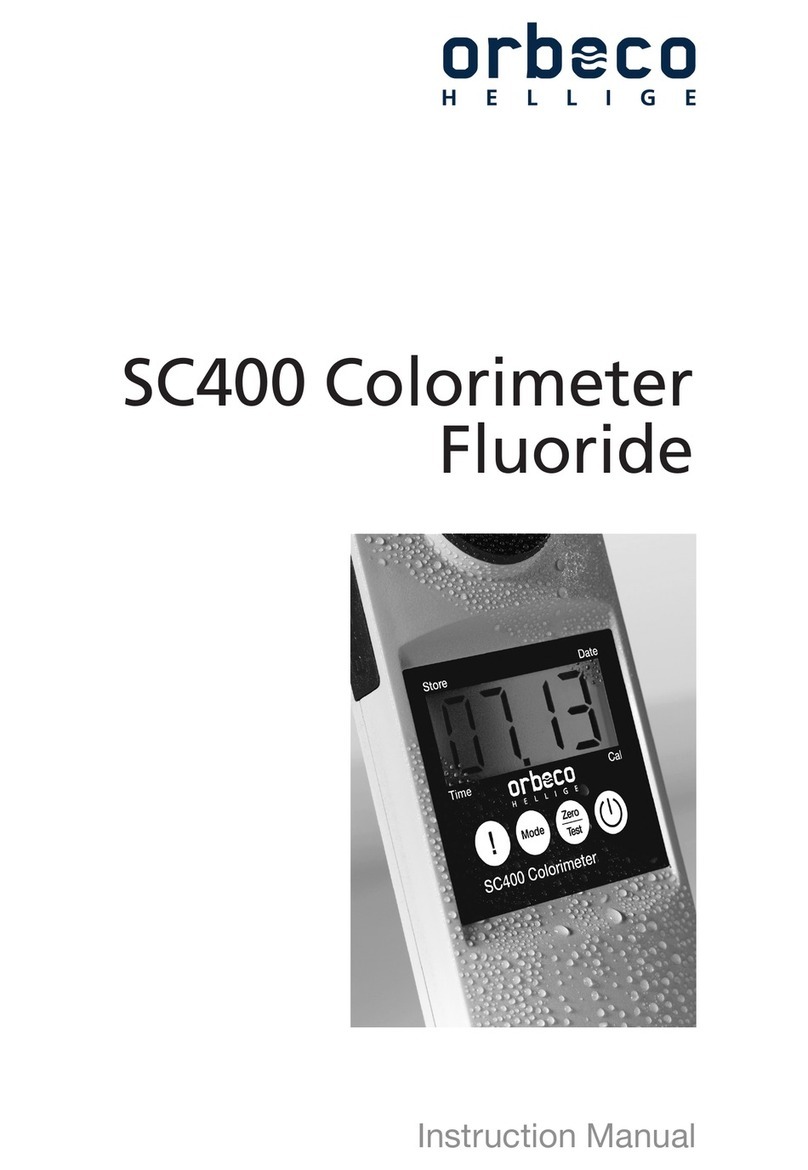
Orbeco HELLIGE
Orbeco HELLIGE SC400 instruction manual
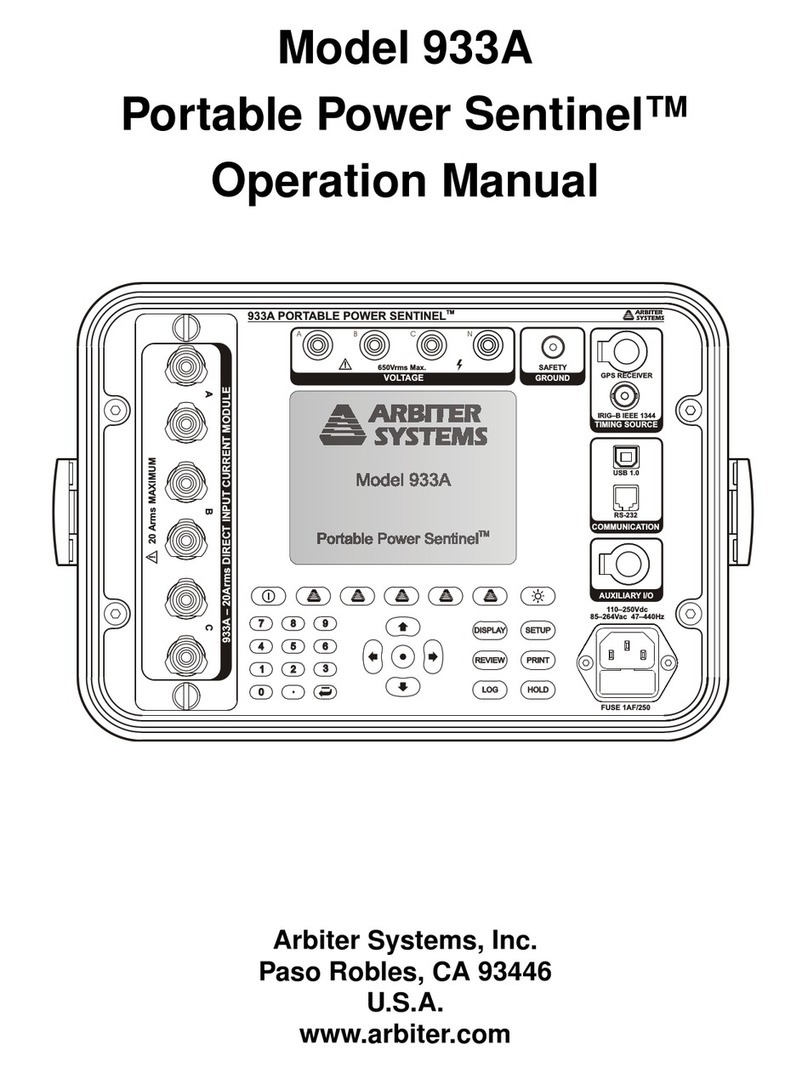
Arbiter Systems
Arbiter Systems Portable Power Sentinel 933A Operation manual
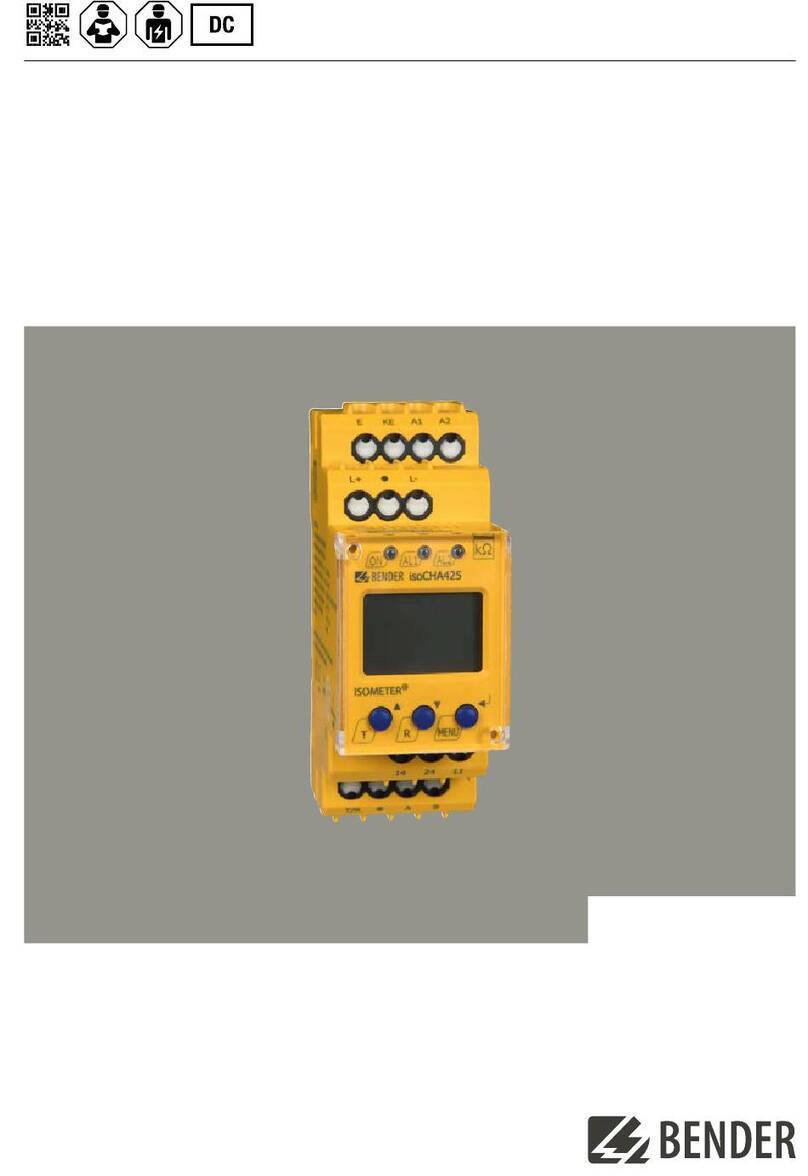
Bender
Bender ISOMETER isoCHA425 quick start guide
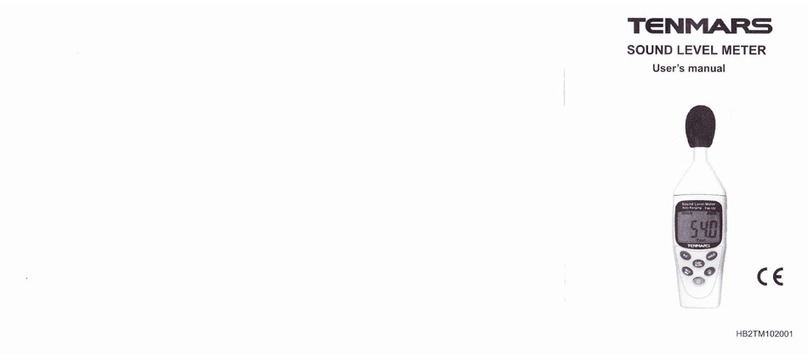
Tenmars
Tenmars HB2TM102001 user manual

Emerson
Emerson Rosemount SOLU COMP II instruction manual
